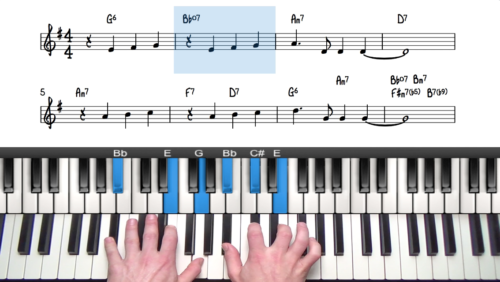Sharp 11 Chord Alteration Drills
Welcome to practice slot 2 in this practice series on altered harmony. In this practice slot we will explore a number of drills and exercises to familiarise ourselves with the sound, colour, and texture of the #11 chord alteration.
The Distinctive Sound Of The #11
The #11 is a very distinctive sound. It has a dreamy, uplifting quality that can be a beautiful addition to dominant chords, and also major chords. For the purpose of this lesson we will be exploring its role over dominant chord voicings.
The first drill is just a 25, so we don’t resolve to the 1 chord.It can be nice just to let that #11 hang and linger on the top of the voicing.
We will demonstrate how to apply this to our playing so that we can see the fruits of our labour by completing these drills.
Lesson Downloads
-
Upper Structure Triad Cheat Sheet File Type: pdf
-
Altered Harmony Practice Planner File Type: pdf
Practice Tips
-
Experiment with the #11 alteration on 25 and 251 progressions in the jazz standards you are playing.
-
First voice the #11 on top of your voicings so that you can hear the sound ringing out above all of the other notes.
-
Spend some time to familiarise yourself with the distinctive 'colour' and 'texture' of the #11.
-
Next apply the #11 in the middle of the voicing as per the examples in this tutorial.







Hi Hayden. In the last 2-5-1 drill, is there a special reason the 5th chord’s 13th is omitted? And also instead of playing like the drills before, which keeps the 5th from the previous 1st chord and becoming the 9th of the 5th chord, this time it goes up a tone and changes to 3rd instead? Sorry it’s a bit difficult to describe in words! Thanks
Hey Erica,
Great question!
Remember that the 5th is not an ‘essential chord tone’ and so it can be omitted from the chord which frees up a finger for a more interesting note choice; in this case we play the #11 which gives the chord a floating character.
The 5th doesn’t change the harmonic quality of the chord (major, minor, dominant) and so it’s often the first note to be omitted. The 3rd and 7th are the essential chord tones, and so generally speaking these tones will always be present.
Personally I wouldn’t look at the 5th of the ii-7 chord ‘moving up’ to the 9th of the V7 chord. I understand what you are saying here, but i would simply look at this as the 5th being omitted from the V7 chord which frees up our finger for the #11th colour tone.
Also notice that the natural 5th and the #11 are just a half step apart, and so if we voice them both in the same chord, it creates a lot of tension and dissonance which does not sound pleasant – to my ears at least!
Please let me know if you have any further questions here.
Talk soon,
Hayden